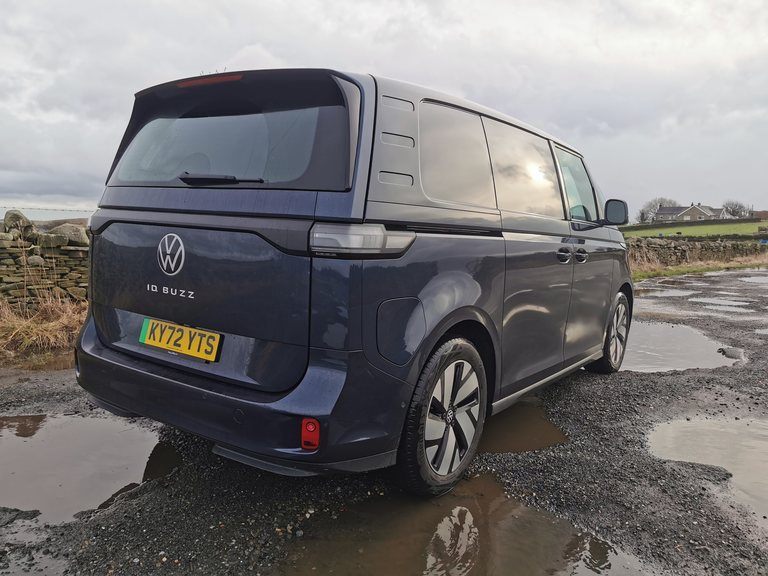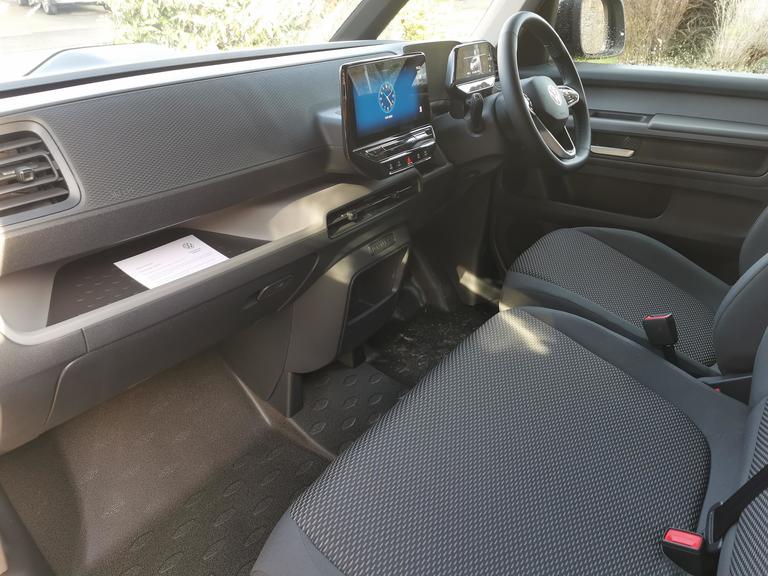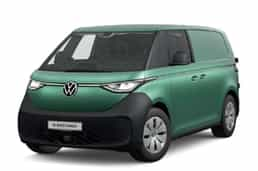Electric Vans / Electric Van Reviews / VW ID Buzz Cargo
It’s got the looks, that’s for sure, but is there substance beneath the style? Our Van Expert Tim Cattlin gets behind the wheel of Volkswagen’s (watch our video review) contender in the small to medium electric van segment…
Volkswagen, despite producing some very tasty looking electric cars, has been a little slow in bringing emission free vans to market. The Crafter has only been available in mainland Europe, and the Transporter, the result of a post-build conversion, hasn’t been popular due to low payload and a poor range. The company has arrived with a bang though with the ID Buzz Cargo which somehow combines retro looks, harking back to the original ‘Bulli’ van with a futuristic, ultra-modern appearance.
At first glance, you’d probably class it as a medium van but it’s probably a halfway house between that and a small one. The load area is bigger than a Caddy Maxi, but smaller than a Transporter and perhaps the only comparable van would be the Maxus eDeliver 3. There’s an argument here that Volkswagen has targeted a customer who wants a van with the style offered by some smaller vehicles but which has a little more room in the loadspace.



Funky? Snazzy? The adjectives could come thick and fast but the ID Buzz Cargo is certainly eye catching. It turned heads wherever I went, and on a couple of occasions, I was approached by other van users after parking up who were curious enough to want to take a closer look and ask questions.
It looks a little like one of the old forward control vans with a relatively flat front, but with modern LED lighting with an inter-connecting LED strip, there’s little doubt from the front at least that this is a modern electric vehicle. On the Commerce Plus model tested (the higher of the two trim levels) the look is enhanced with some very smart diamond cut 19” alloy wheels, and the tailgate spoiler gives the rear perspective a look which compliments the rest of the design.
At the time of writing, there’s just a single body length available, although the manufacturer has promised a longer variant in the near future. A glazed lift-up tailgate and twin side doors offer easy access to the 3.9 cubic metres of load volume, and you’ll get a load of up to 2208mm in length inside the van. Payload is disappointing at just 592kgs, but I’d guess that the typical owner of this van won’t be frequenting the builder’s merchants that often. This aspect shouldn’t be trivialised though and may lose Volkswagen some sales to those that need to carry a reasonable amount of weight.
It’s great to see LED lighting in the loadspace helping the driver to locate that elusive parcel, and the area is protected by a wooden floor with a slip-resistant surface. The bulkhead is glazed, but this seems a little pointless as the view from the cab is almost totally obscured by a passenger head restraint.
Given the uber-modern exterior, you’d expect the cab interior to reflect this, and you’re unlikely to be disappointed. The 10” landscape orientated multimedia screen provides access to a plethora of functions, including Apple and Android smartphone integration together with vehicle system functions including cab pre-conditioning. There’s a fully digital instrument panel in front of the driver displaying all the usual information but also the charge state of the battery.
There’s plenty of cab storage on offer including a large dash top, and Volkswagen hasn’t been shy when it comes to the provision of 12v power and USB sockets. The Commerce Plus model is well equipped, with the likes of air conditioning, a heated driver’s seat and windscreen, satellite navigation, adaptive cruise control and a rear view camera all coming as standard. There are also plenty of advanced driver and safety aids.
The aspect that might be of interest to most – the fully electric drivetrain. There’s a hefty 204PS motor which is fuelled by an equally substantial 77kWh battery. The official WLTP Combined cycle range of 254 miles from a full charge is class leading by a country mile but, I’m left wondering if Volkswagen has sacrificed payload for range by the fitting of a heavier, larger battery pack than those offered by competitors. Others, such as Maxus allow the customer to choose between these aspects by offering multiple battery options so that those that need payload over range are catered for as much as others which need maximum distance on a full charge.
Charging can take as little as 7.5 hours from an 11kw wallbox, and if the van is hooked up to a 170kW DC rapid charger, a 5% to 80% top-up will take just 30 minutes.
Once comfortable, the driver pushes a button to switch everything on, and drive is selected by twisting a column mounted stalk. I tend to prefer a centre mounted drive control but, in all fairness, I soon became accustomed to this which allows for a quick and easy change from drive to reverse. As you’d expect, forward motion is almost silent and before too long you’re aware that the manufacturers quoted 0-62mpg acceleration time of just 10.2 seconds is an excellent indication of just how spritely the van is on the road. It’s really quite quick and, where permitted will achieve 90mph. Many electric vans are speed limited, presumably to maintain a decent range but Volkswagen has allowed the driver to make the choice of distance over speed. Using the braking effect provided by the recuperation facility (where the motor provides drag and places charge back into the battery when coasting) a smooth, effortless drive is provided, particularly in urban areas.
The level of build quality of a van can be judged by many factors, but there’s no doubt that the ID Buzz Cargo excels in this regard. Materials seem to be of the highest quality, and there are no squeaks, knocks or rattles. The van also drives very well indeed, handling when the van is pushed is drama free and the steering has just the right amount of feel.
The driving position is excellent and the seat is possibly the most comfortable I’ve experienced in any van. Visibility isn’t the best though, despite the deep windscreen. My issue was with the small ‘quarter window’ at the front of the driver’s door. The obstruction from the window’s dividing pillar saw me moving my head back and forth when manoeuvring. Not a major issue, but I found it irritating.
The range remaining indicator on the instrument panel I found to be a little optimistic. If I went for a 30 mile drive in good weather with no load on, typically the range would drop by 35 miles. Selecting mode B in the drive options provides maximum recuperation which can add useful range back into the battery pack.
There’s no doubt that this is a niche product. Volkswagen is targeting the image conscious, perhaps artisan businesses, with a van that most would agree, looks superb. But it not only looks good, it drives well and has an excellent range between charges. I can see this van proudly displayed on a driveway where the owner would previously have parked his or her prestige car. Issues? That payload will put some off, and for Volkswagen, I’m not sure how big the market is for a van like this.
 Ask for AvailabilityVw Id Buzz CargoId.buzz Cargo 150kW 77kWh Commerce Auto
Ask for AvailabilityVw Id Buzz CargoId.buzz Cargo 150kW 77kWh Commerce Auto
Go to deal